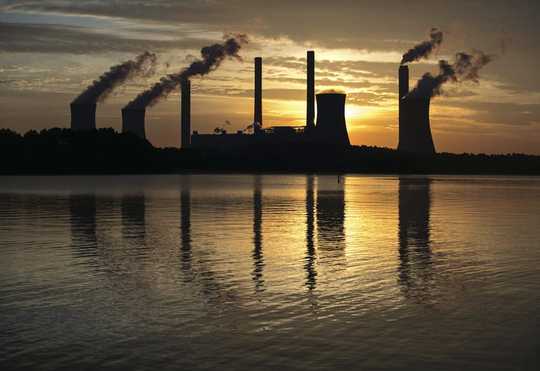 The coal-fired Plant Scherer, one of the top carbon dioxide emitters in the United States, stands in the distance in Juliette, Ga. (AP Photo/Branden Camp)
The coal-fired Plant Scherer, one of the top carbon dioxide emitters in the United States, stands in the distance in Juliette, Ga. (AP Photo/Branden Camp)
The “tragedy of the horizons,” a term coined by Canada’s Mark Carney, governor of the Bank of England, has been haunting the financial sector ever since climate change began posing serious threats to the planet.
As Carney put it: Can the financial sector address long-term climate change problems when most investments are made for the short term?
Behavioural economics has shown us that people lack the ability to think long term, and this has been the Achilles heel in our fight against climate change. However, there’s now evidence that the “tragedy of the horizons” could be overcome due to changes in both our behaviour and our financial system.
Over the past few years, the idea of business-as-usual in the financial sector has been questioned by many. The wisdom so far has been to invest in what provides us with the lowest risk and has long-term stability.
 Bank of England governor Mark Carney is seen here in Toronto in 2016 participating in a discussion on climate change initiatives for the financial sector in Canada and the world. (THE CANADIAN PRESS/Chris Young)
Bank of England governor Mark Carney is seen here in Toronto in 2016 participating in a discussion on climate change initiatives for the financial sector in Canada and the world. (THE CANADIAN PRESS/Chris Young)
However, in the age of climate change, notions of risk and stability are constantly changing.
Today, investors assess risk not just in terms of financial risk, but also social, environmental and governance (ESG) issues that may be critical to financial returns. Investors are demanding that investment firms start to factor in ESG components.
Green bonds changing financial sector
Green bonds, debt finance tools that have traditionally been used to raise long-term capital with low risk, may be answering the call for behavioural change in the financial sector.
Ever since the Industrial Revolution, bonds have played a critical role in financing infrastructure in cities and towns. A green bond transforms these infrastructure-related investments into low-carbon, climate change-resilient alternatives. Green bonds don’t just have the capacity to address risk and stability in a way that considers the long-term impact of climate change — they can also change the way we think about money and returns as well.
With US$100 billion invested in green projects in 2017 alone, socially responsible investment products like green bonds have the potential to create massive change.
Green bonds not only provide similar financial returns as regular bonds, but also allow for a bonus “green” return from their investments. These bonus moral incentives could finally be starting to create a social and environmental conscience in the financial sector. Indeed, as more investors push for green bonds, climate change awareness continues to grow.
That means investors, and the financial sector as an extension, are starting to think long term about climate change. What’s even more exciting is that the transformation to a low-carbon financial system is happening simultaneously around the world.
Several countries are issuing what are known as green economy road maps. Private sector green bonds are on the rise, and the process of divestment from fossil fuels has begun.
Impact on global financial system
There is now momentum for innovation in the financial sector, and it’s changing how we think about our traditional investment portfolios, banking, credit and even fintech.
For a long time, socially responsible investing and its products were a niche market. However, with the advent of the green bond, this niche market is transitioning to the mainstream. According to the Climate Bonds Initiative, the market has surpassed the US$100 billion mark, with $116.8 billion being issued in 2017 alone. That’s substantially more than the money that flows across global borders as official developmental aid for tackling climate change.
To really understand the magnitude of the impact of green bonds, let’s look at the size of the market.
Currently, climate-aligned bonds are estimated to total US$895 billion, which is a $201 billion increase from the previous year. Out of that $895 billion, approximately $221 billion are labelled as green bonds. This growth is encouraging, but there’s room for a much larger market given the increasing number of extreme weather events linked to climate change.
As those major floods and monster hurricanes continue, industries like the insurance sector will be less likely to take on clients or insure assets that do not meet climate change resilience standards. This is where having low-carbon, infrastructure-related investments from green bonds in a climate-resilient economy will make a big difference.
Interestingly, governments and public institutions account for almost 68 per cent of this amount, and developing countries such as China are currently leading the market. This exponential growth points to two things: Governments have a key role to play in the transitioning of this market, and perhaps this transition will be driven by emerging economies like China’s.
 A man and a child wear masks during a heavy pollution day in Beijing, China, in 2016. China announced plans to curb greenhouse gas emissions over the next several years. (AP Photo/Ng Han Guan)
A man and a child wear masks during a heavy pollution day in Beijing, China, in 2016. China announced plans to curb greenhouse gas emissions over the next several years. (AP Photo/Ng Han Guan)
The regulatory impact
So how much of an impact can government pressure have on the shift to a low-carbon economy? Looking at China as an example, our previous study at the University of Waterloo shows such pressure has indeed resulted in creating both financial and sustainability improvements in the credit businesses of Chinese banks.
Under the Chinese Green Credit Guideline Policy, banks reduced how much environmental risk they were exposing themselves to, especially when lending to their clients.
The guidelines forced banks to become financially and environmentally prudent in addressing climate change risks. The study found that there were improvements in both financial and sustainability performances, and the common linkage was the institutional impact of the Chinese public policy.
If such regulatory pressure can be replicated in the green bond market, it could bring about a low-carbon economy. Furthermore, green bonds could soon be subject to standardizations and certifications. With increasing fears of “green-washing” and concerns from investors about being misled by the green label, regulating the market would be beneficial — and could ensure green bonds continue to play an important role in fighting climate change.![]()
About The Authors
Olaf Weber, Professor of Sustainable Finance and Banking, University of Waterloo and Vasundhara Saravade, Masters Candidate in Environmental Finance and Sustainability Management, University of Waterloo
This article is republished from The Conversation under a Creative Commons license. Read the original article.
Related Books
Drawdown: The Most Comprehensive Plan Ever Proposed to Reverse Global Warming
by Paul Hawken and Tom Steyer In the face of widespread fear and apathy, an international coalition of researchers, professionals, and scientists have come together to offer a set of realistic and bold solutions to climate change. One hundred techniques and practices are described here—some are well known; some you may have never heard of. They range from clean energy to educating girls in lower-income countries to land use practices that pull carbon out of the air. The solutions exist, are economically viable, and communities throughout the world are currently enacting them with skill and determination. Available On Amazon
In the face of widespread fear and apathy, an international coalition of researchers, professionals, and scientists have come together to offer a set of realistic and bold solutions to climate change. One hundred techniques and practices are described here—some are well known; some you may have never heard of. They range from clean energy to educating girls in lower-income countries to land use practices that pull carbon out of the air. The solutions exist, are economically viable, and communities throughout the world are currently enacting them with skill and determination. Available On Amazon
Designing Climate Solutions: A Policy Guide for Low-Carbon Energy
by Hal Harvey, Robbie Orvis, Jeffrey Rissman With the effects of climate change already upon us, the need to cut global greenhouse gas emissions is nothing less than urgent. It’s a daunting challenge, but the technologies and strategies to meet it exist today. A small set of energy policies, designed and implemented well, can put us on the path to a low carbon future. Energy systems are large and complex, so energy policy must be focused and cost-effective. One-size-fits-all approaches simply won’t get the job done. Policymakers need a clear, comprehensive resource that outlines the energy policies that will have the biggest impact on our climate future, and describes how to design these policies well. Available On Amazon
With the effects of climate change already upon us, the need to cut global greenhouse gas emissions is nothing less than urgent. It’s a daunting challenge, but the technologies and strategies to meet it exist today. A small set of energy policies, designed and implemented well, can put us on the path to a low carbon future. Energy systems are large and complex, so energy policy must be focused and cost-effective. One-size-fits-all approaches simply won’t get the job done. Policymakers need a clear, comprehensive resource that outlines the energy policies that will have the biggest impact on our climate future, and describes how to design these policies well. Available On Amazon
This Changes Everything: Capitalism vs. The Climate
by Naomi Klein In This Changes Everything Naomi Klein argues that climate change isn’t just another issue to be neatly filed between taxes and health care. It’s an alarm that calls us to fix an economic system that is already failing us in many ways. Klein meticulously builds the case for how massively reducing our greenhouse emissions is our best chance to simultaneously reduce gaping inequalities, re-imagine our broken democracies, and rebuild our gutted local economies. She exposes the ideological desperation of the climate-change deniers, the messianic delusions of the would-be geoengineers, and the tragic defeatism of too many mainstream green initiatives. And she demonstrates precisely why the market has not—and cannot—fix the climate crisis but will instead make things worse, with ever more extreme and ecologically damaging extraction methods, accompanied by rampant disaster capitalism. Available On Amazon
In This Changes Everything Naomi Klein argues that climate change isn’t just another issue to be neatly filed between taxes and health care. It’s an alarm that calls us to fix an economic system that is already failing us in many ways. Klein meticulously builds the case for how massively reducing our greenhouse emissions is our best chance to simultaneously reduce gaping inequalities, re-imagine our broken democracies, and rebuild our gutted local economies. She exposes the ideological desperation of the climate-change deniers, the messianic delusions of the would-be geoengineers, and the tragic defeatism of too many mainstream green initiatives. And she demonstrates precisely why the market has not—and cannot—fix the climate crisis but will instead make things worse, with ever more extreme and ecologically damaging extraction methods, accompanied by rampant disaster capitalism. Available On Amazon
From The Publisher:
Purchases on Amazon go to defray the cost of bringing you InnerSelf.comelf.com, MightyNatural.com, and ClimateImpactNews.com at no cost and without advertisers that track your browsing habits. Even if you click on a link but don't buy these selected products, anything else you buy in that same visit on Amazon pays us a small commission. There is no additional cost to you, so please contribute to the effort. You can also use this link to use to Amazon at any time so you can help support our efforts.

























